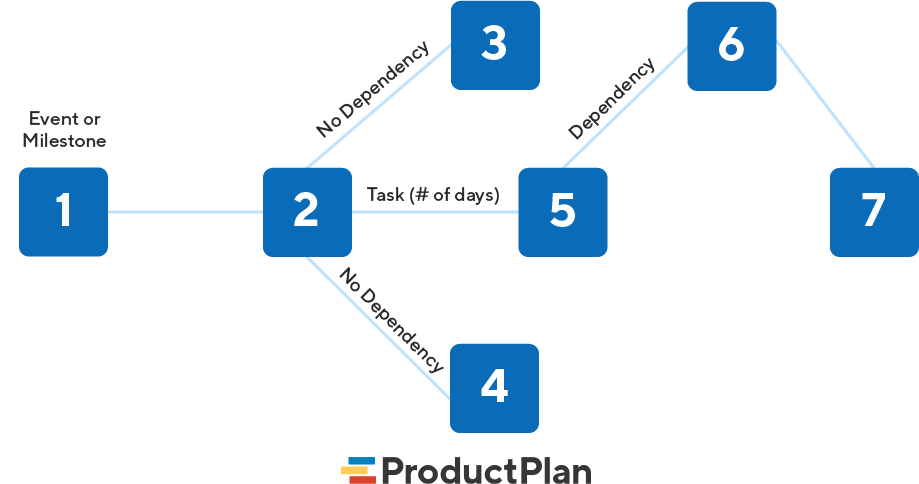How To Draw A Pert Diagram
What Is a PERT Chart?
A PERT nautical chart is a visual projection management tool used to map out and track the tasks and timelines. The name PERT is an acronym for Project (or Program) Evaluation and Review Technique.
How Is a PERT Nautical chart Dissimilar from a Gantt Chart?
PERT charts are similar to Gantt charts in that they offer a graphical view of a project'due south tasks, schedule, and timelines. Merely there are several significant differences between these 2 types of project management diagrams:
one. Gantt charts are bar graphs; PERT charts are gratis-form
Gantt charts are drawn every bit bar graphs along a timeline, equally shown below. They correspond the tasks and phases of a project with horizontal confined, each drawn to a length representing its estimated timeframe.
A PERT chart, by dissimilarity, tin can be drawn as a complimentary-class diagram. Project managers create PERT charts by cartoon boxes or circles ("nodes") representing events or milestones and connecting them via arrows, representing the tasks that must be completed between each milestone and the corporeality of fourth dimension the team will have to consummate each task.
2. PERT charts illustrate dependencies; Gantt charts practice not
1 disadvantage of using a Gantt chart to track a project is that information technology does not indicate task dependencies. Each bar on the graph stands alone. This makes it hard for project managers to know how much ane missed borderline could affect other nautical chart tasks.
PERT charts solve this challenge with the use of directional arrows. These directional (or "concurrent") arrows indicate that a series of tasks must exist completed in sequence because they have interdependencies. On the other hand, diverging arrows indicate functions that tin be completed parallel or out of order considering they do not have dependencies.
In the PERT chart example beneath, y'all can see the task represented in node 1 has a dependency considering its arrow goes merely to node ii. From node ii, withal, the team may piece of work on either or both of the tasks represented by the diverging arrows going to nodes three and 4. Therefore, these activities exercise not take dependencies.

What Should a PERT Nautical chart Template Include?
To explain the components of a typical PERT chart, let'south apply this mockup of a hypothetical marketing squad's programme to roll out a new campaign.
- Numbered nodes
These are the numbered boxes y'all run across in the PERT chart case above. (Some projection managers choose to draw them as circles.)
Each node represents an event or milestone in the project, completion of 1 stage, or a series of tasks needed to move the projection forward.
- Directional (or concurrent) arrows
The arrows on a PERT chart represent the tasks or activities that need to be completed before the team can move on to the next result or phase in the projection.
The chore between nodes 1 and two ("identify market place segment") is a directional or concurrent arrow in the mockup above. This indicates the job must be completed in the sequence indicated. Project managers use directional arrows to schedule activities that take dependencies.
- Divergent arrows
These arrows represent tasks that a team may work on simultaneously or in any sequence they choose considering they do non take dependencies. In the mockup here, you can meet an case of this subsequently node 2, for example. The team may piece of work first on the activities leading to node 3 or node iv, or they may choose to complete them simultaneously.
What Are the 4 Steps to Create a PERT Nautical chart?

To create a PERT nautical chart, a projection direction team should follow these steps.
Step 1: Identify all of the project'southward activities.
First, ascertain all of the major phases, milestones, and tasks needed to complete the project.
Step two: Identify dependencies
If you lot determine some tasks or activities take dependencies, you volition want to depict those tasks with directional arrows. This will ensure your squad knows the sequence they need to tackle each job.
Pace 3: Draw your chart.
The next step is to take the events and milestones (numbered nodes) you've identified and draw them out. And then write out the tasks and activities that the team must complete between each node, using directional arrows or divergent arrows accordingly.
Pace 4: Found timelines for all activities.
Y'all should now set a timeframe when the squad volition need to complete those tasks forth with all arrows. For example, in our mockup above, you tin can come across the "Train sales" activity has a timeframe of 1 solar day. This tin can represent the estimated timeframe and/or borderline you set for the activity.
Related Terms
Gantt chart / project roadmap / timeline roadmap / Kanban board / agile production owner /
Acquire More Ways to Create Strategic Documents for Your Team
Download our Roadmap Template Guide
Source: https://www.productplan.com/glossary/pert-chart/
Posted by: inmansomper.blogspot.com


0 Response to "How To Draw A Pert Diagram"
Post a Comment